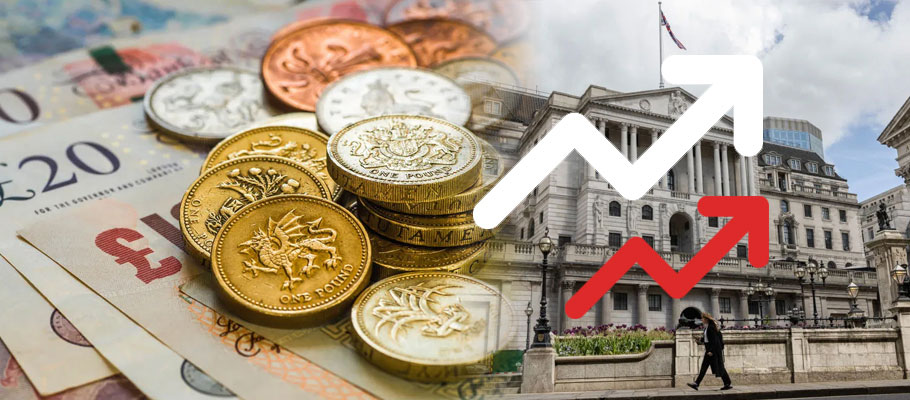
Published: December 13th, 2023
A new analysis from investment bank Panmure Gordon says economic indicators shows the UK economy is outperforming the Bank of England's (BoE) most recent outlook.
Just one month on from the BoE’s last set of forecasts in November, Panmure says all the central bank’s core assumptions are already proving to be too pessimistic.
The upbeat economic signals that have emerged since suggest that the UK’s central bank, which has held interest rates at elevated levels for longer than investors were expecting, might have been able to anticipate more robust performance.
Bank analysts say that if Britain’s economy continues on its current path, BoE policymakers ‘can expect more criticism in the coming weeks’.
The Bank’s core assumptions (referred to as ‘conditioning assumptions’ in its forecasts), have determined its GDP and CPI forecasts, which have both moved significantly upward in the past 30 days.
The Bank of England’s November Monetary Policy Report had the Bank Rate averaging as much as 5.1 per cent next year. Panmure Gordon says investors are now challenging all G10 central banks by looking for a 4.8 per cent rate in 2024.
Forex traders have been raising their bets for interest rate cuts at the BoE and other major central banks in recent weeks. Some have been targeted more than others, as evidenced by the Euro’s recent dip following a surge in speculative positions based on expected rate cuts by Frankfurt.
Panmure’s analysis points to easing money market pricing and looser financial conditions in major Western markets. The evidence, they say, can be found in the UK debt products are being priced in forward swaps.
The bank notes that GBP has performed better than expected, with trade-weighted Pound Exchange rate now two per cent higher at 82. That could soften the impact of imported inflation in 2024 as un- favourable currency hedges from Q4 2022 are closed.
In June, forex traders were increasing speculative bets on the Pound, believing it was set to strengthen against a backdrop of rising positive sentiment.
Data published this week by the US Commodity Futures Trading Commission (CFTC) shows that bullish positions on GBP rose by USD 3.2 billion in the seven days leading up to Wednesday, 21st June.
There was significant growth in 'long' contracts, with 37,110 new positions indicating growing optimism in the UK currency's prospects.
A ‘long’ position means a trader opens a contract based on a presumed future rise in the price of an underlying asset, in this case the asset being Pounds Sterling.
Analysts at MUFG told Bloomberg that speculative traders have ‘aggressively pursed net-GBP longs’ over the past fortnight. The recent boost has created the biggest net long position on GBP held by Leveraged Funds since September of 2022.
For the seven-day trend noted in the CFTC’s report, it was the biggest one-week jump seen since April 2016. But MUFG analysts believe the cumulative net GBP long is the biggest since 2014.
‘Traders have been slowly leaning into Sterling since April, but the jump seen last week is very significant.’
The surge in bullish Pound positions reflects a growing consensus among leveraged fund investors that the Bank of England’s shift to aggressive monetary tightening will have a positive effect on the currency.
Threadneedle Street surprised investors last week by raising interest rates 50 basis points, a big leap from the successive 25bp hikes seen previously.
Traders are now looking for Britain’s base rate to settle at or above six per cent, meaning the UK would have the highest rate amongst G10 countries.
In May, Sterling gave back gains against the Dollar and Euro following publication of UK wage and employment data that indicated Britain’s labour market had reached a Spring inflexion point.
According to the UK Office of National Statistics (ONS), average UK earnings rose by 6.6 per cent in March, slightly less than the 6.7 per cent figure consensus had expected, but still a shade above April's 6.5 per cent.
With bonuses factored in, the figure was 5.9 per cent, which was anticipated, and holding steady at the previous month’s level.
Bank of England (BoE) policymakers have been especially focused on wage data as they look for signals that UK inflation is becoming embedded. While the numbers are robust, Threadneedle Street may conclude that wage increases are close to reaching a peak, especially if unemployment continues to rise.
Alongside the wage rise, Britain’s unemployment rate increased to 3.8 per cent in March. Consensus had expected unemployment to remain unchanged at the previous month’s 3.7 per cent.
The data may signal that the hot UK labour market may finally be starting to cool, potentially giving the Bank of England breathing space to look again at concluding the current interest rate hiking cycle.
The Pound was unsurprisingly softer in the wake of the data release. The Pound to Dollar rate dropped 0.30 per cent in the 30 minutes following the release to 1.2474. The Pound to Euro rate fell 0.20 per cent in the same period, dropping to 1.1479.
A month later, UBS Bank advised its forex clients to consider long positions on Sterling against the Swiss franc, suggesting a move to 1.14 could be in the offing.
In an analyst note published the w/c 12th June, the bank’s Currency Strategy Unit said the recommendation is supported by solid technical indicators and strong fundamental support.
The note pointed to an attractive valuation for Sterling against the Franc and said the previous downward pressure on GBP could be blamed on political uncertainty and investor perceptions that British monetary policy had become somewhat ‘loose’.
That all changed, UBS said, because UK politics had stabilised and the Bank of England (BoE) was showing stronger commitment to fighting inflation. These positives had yet to be fully reflected in GBP’s valuation but could become evident before the end of the calendar month.